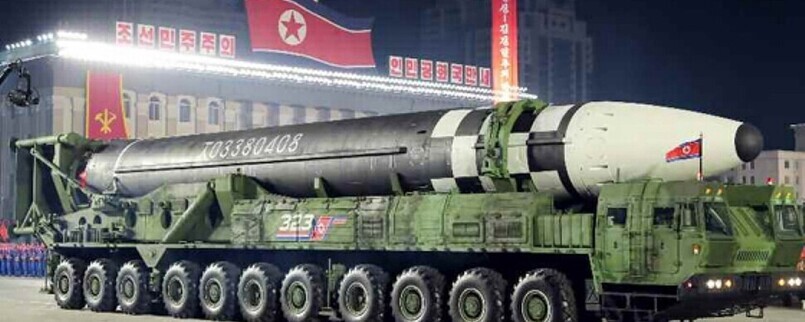hankyoreh
Links to other country sites 다른 나라 사이트 링크
N. Korea has cut S. Korea’s lead in missile technology by half, weapons development expert says

Nam Sae-kyu, head of South Korea’s Agency for Defense Development (ADD), said on Oct. 20 that North Korea’s recent advances in missile technology had cut South Korea’s 20-year lead by more than half.
Nam made the comments during the parliamentary audit for the Defense Acquisition Program Administration (DAPA), in the National Assembly’s National Defense Committee on Tuesday. He’d been asked about the level of the weapons that appeared in a recent North Korean military parade.
“We have a considerable lead [in terms of missile and guided-weapon technology],” Nam said. “I’d thought we were 20 years ahead in terms of solid-fuel ballistic projectiles and missiles, but [seeing North Korea’s military parade] made me think they’ve really cut into our lead, that they’ve reduced it by more than half.”
“I got the impression that North Korea has made incredible practical advances over the past five years. The North is [developing] much faster than we thought.”
Nam also commented on the new intercontinental ballistic missile (ICBM) that North Korea unveiled in the military parade. “The launch vehicle has 11 axles, but North Korea doesn’t have the infrastructure or factories to build that kind of vehicle. I guess they smuggled in a logging truck or assembled it from imported parts.”
Nam said that the North’s new submarine-launched ballistic missile (SLBM), called the Pukguksong-4ㅅ (ㅅ is a Korean letter), “seems to be nearly the same size as the Pukguksong-3. The exterior looks similar, with a diameter of around 1.7 meters. So I don’t think there would be much of a difference in its range.”
Nam observed that the new missile differs from the Pukguksong-3 in regard to the location of its first-stage propulsion system. “They seem to have changed that because of an issue with flight stability [in the Pukguksong-3]. That suggests that the North has obtained considerable ability in developing solid-fuel ballistic missiles,” Nam said.
Nam said the reason for North Korea’s rapid development of missile technology is that “the North lets its researchers focus on their work. The researchers are told to focus on the progress they make despite various failures and other issues. But South Korean researchers are forced to deal with a lot of issues before moving forward, which is why it takes us longer to get results.”
By Park Byong-su, senior staff writer
Please direct comments or questions to [english@hani.co.kr]

Editorial・opinion
![[Column] Season 2 of special prosecutor probe may be coming to Korea soon [Column] Season 2 of special prosecutor probe may be coming to Korea soon](https://flexible.img.hani.co.kr/flexible/normal/500/300/imgdb/original/2024/0426/3317141030699447.jpg) [Column] Season 2 of special prosecutor probe may be coming to Korea soon
[Column] Season 2 of special prosecutor probe may be coming to Korea soon![[Column] Park Geun-hye déjà vu in Yoon Suk-yeol [Column] Park Geun-hye déjà vu in Yoon Suk-yeol](https://flexible.img.hani.co.kr/flexible/normal/500/300/imgdb/original/2024/0424/651713945113788.jpg) [Column] Park Geun-hye déjà vu in Yoon Suk-yeol
[Column] Park Geun-hye déjà vu in Yoon Suk-yeol- [Editorial] New weight of N. Korea’s nuclear threats makes dialogue all the more urgent
- [Guest essay] The real reason Korea’s new right wants to dub Rhee a founding father
- [Column] ‘Choson’: Is it time we start referring to N. Korea in its own terms?
- [Editorial] Japan’s rewriting of history with Korea has gone too far
- [Column] The president’s questionable capacity for dialogue
- [Column] Are chaebol firms just pizza pies for families to divvy up as they please?
- [Column] Has Korea, too, crossed the Rubicon on China?
- [Correspondent’s column] In Japan’s alliance with US, echoes of its past alliances with UK
Most viewed articles
- 1‘We must say no’: Seoul defense chief on Korean, USFK involvement in hypothetical Taiwan crisis
- 2After election rout, Yoon’s left with 3 choices for dealing with the opposition
- 3Why Kim Jong-un is scrapping the term ‘Day of the Sun’ and toning down fanfare for predecessors
- 4AI is catching up with humans at a ‘shocking’ rate
- 5Two factors that’ll decide if Korea’s economy keeps on its upward trend
- 6Division commander ordered troops to enter raging flood waters before Marine died, survivor says
- 7[Column] Park Geun-hye déjà vu in Yoon Suk-yeol
- 8[Editorial] Korea’s surprise Q1 growth requires objective assessment, not blind fanfare
- 9No good, very bad game for Korea puts it out of Olympics for first time since 1988
- 10Noting shared ‘values,’ Korea hints at passport-free travel with Japan